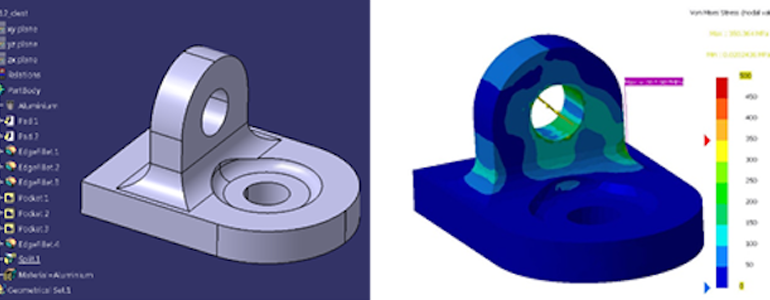
Design Validation using CATIA Finite Element Analysis
Table of contents
Design Validation
For individual part design, GPS licences are used and for assembly analysis, GAS. This functionality can be extended using the EST licence which allows users to perform finite element analysis of the composites and comparative study of analysis. All three of these functionalities provide fairly accurate results with linear behaviour of stress strain curve.
To perform the finite element analysis of the parts in the nonlinear region of the stress strain curve, we need to use an Advanced Nonlinear licence. Thermal analysis can be performed by using the Advanced Thermal and Heat Transfer Analysis licence.
CATIA V5 also offers efficient meshing tools. The FMS licence allows users to mesh surface geometry while the FMD licence allows the mesh of solid geometry. The mesh geometry in CATIA can be exported to different solvers and post processors by using various link tools available within CATIA.
By default CATIA uses the Elfini solver for finite element analysis.
This solver provides good results within the linear range of stress-strain graph. These results can be further improved using the Abaqus solver, one of the most highly accurate solvers. The Abaqus for CATIA licence allows users to run the CATIA analysis job using the Abaqus solver. For this, licenced access to Abaqus tokens is required, in addition to CATIA licences.
Just like any solver, CATIA also allows users to automate the process of the finite element analysis by using concept of publications and template creation.
Composite Link functionality within CATIA allow users to import and export finite element analysis data from any finite element analysis solver to CATIA.
The biggest advantage of using CATIA for design validation is the associativity with CATIA parts. Any change in CATIA parts (Geometry, Material Assigned) are immediately reflected in the finite element analysis scenario. As the required steps are very simple, the designer will able to perform simple finite element analysis of the parts and see the effect of change on the strength of the geometry.
What Are the Benefits of CATIA FEA?
- Integrated into CATIA
- Same interface as the design environment
- Analysis specifications fully associative with design
- Easily understand whether design changes improve the performance
- Properly size the design, add material only where it is needed
- Realistic and robust modelling
- Hybrid assemblies
- Solid, shell, wireframe geometry
- Allow several designers to work together using assembly of analyses
- Realistic connections to surrounding parts
- Bolts, contact, welds
- Easily compare design alternatives using parameters and design tables
- Geometric parameters
- Materials
- Mesh parameters
- Loads
- Optimise structures to meet targets
- CATIA V5 Analysis with CATIA Product Engineering Optimizer (PEO) can be used to arrive at the best design faster
- Drive parameters to reach defined objectives
- Minimize mass, Maximize stiffness, Stress/displacement requirement
- Deploy proven workflows to designers
- Packaged templates based on CATIA Knowledgeware
- Designer can focus on the geometry, the template builds the analysis
- All analysis features can be automated
- Mesh, Connections, Loads/Restraints, Reports
- Have confidence in results
- Eliminate mesh-related uncertainty with automatic mesh adjustments
- Provide a balance between solution accuracy and cost
Want to know more?
Join TECHNIA for one of three TRY CATIA for CAE workshops, allowing attendees to experience CATIA V5 Analysis through real life use in order to understand its benefits. FREE to attend, however spaces are limited. Due to the hands on training environment of the workshop, places are allocated on a first come, first served basis.
Discover CATIA Analysis



